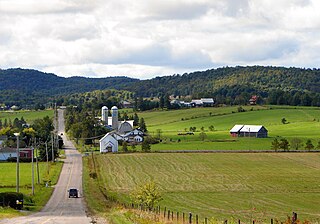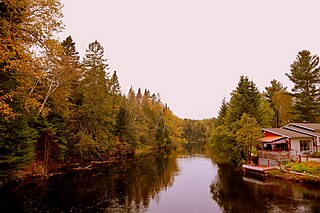
Antoine-Labelle is a regional county municipality located in the Laurentides region of Quebec, Canada. Its seat is Mont-Laurier. It is named for Antoine Labelle.

Route 344 is an east/west highway on the north shore of the Ottawa River in Quebec, Canada. Its western terminus is in Grenville-sur-la-Rouge at the junction of Autoroute 50, and its eastern terminus is in L'Assomption at the junction of Route 343. It follows the Ottawa River from Grenville-sur-la-Rouge to Saint-André-d'Argenteuil, where it follows the Lac des Deux Montagnes until Deux-Montagnes, where it follows the Rivière des Mille Îles until Repentigny, where it follows the Rivière l'Assomption until L'Assomption.

Grenville-sur-la-Rouge is a municipality in the Argenteuil Regional County Municipality in the Laurentides region of Quebec, Canada. It is a predominantly Francophone community situated along the southern border of Quebec between Montreal and Ottawa.

The Sir Wilfrid Laurier School Board is a school board headquartered in Rosemère, Quebec in Greater Montreal.

Nominingue is a small village and municipality located 200 kilometres (120 mi) north of Montreal, Quebec, Canada, in the Laurentian Mountains. It was formerly called Lac-Nominingue, but changed name on September 16, 2000.

Mont-Tremblant National Park is a provincial park in Canada located north of the town of Mont-Tremblant, and the village of Saint-Donat and Saint-Côme, in the administrative regions of Laurentides and Lanaudière, in Quebec, in Canada.

Rivière-Rouge is a city located in the Antoine-Labelle Regional County Municipality, Quebec, Canada. The population as of the 2021 Canadian census was 4,631.

Harrington is a township municipality in the Laurentides region of Quebec, Canada, part of the Argenteuil Regional County Municipality. It is located in the Laurentian Mountains, about 40 kilometres (25 mi) north-west of Lachute.

Saint-André-d'Argenteuil is a municipality in the Laurentides region of Quebec, Canada, part of the Argenteuil Regional County Municipality. It is located along the Ottawa River, just south of Lachute.

Lac-Saguay is a village municipality in Antoine-Labelle Regional County Municipality in the Laurentides region of Quebec, Canada.

The Montmorency River is a tributary of North-East bank of St. Lawrence river, flowing in the administrative region of Capitale-Nationale, in the province of Quebec, Canada. The course of the river successively crosses the regional county municipality of:

Rivière du Nord is a 137 km (85 mi)-long river in the Laurentides region that flows into the Ottawa River. The river begins as the outlet of Lac Brulé where it passes near Sainte-Agathe-des-Monts and flows southeasterly. Quebec Autoroute 15 follows the course of the Rivière du Nord valley north of Montréal providing access to many cottages and vacation homes. At Saint-Jérôme, the river turns southwesterly where it continues to its mouth on the left bank of the Ottawa River. In addition to Saint-Jérôme, towns built along the Rivière du Nord's banks include Val-David, Val-Morin, Saint-Adèle, Prévost, and Lachute.

The Matawin River is a 161-kilometre (100 mi) river, flowing from west to east through the administrative regions of Lanaudière and Mauricie, in Quebec, Canada.
The Rouge-Matawin Wildlife Reserve is a Quebec Wildlife Reserve located to the north of Mont-Tremblant National Park, in Quebec, Canada.

The Bazin River is a river in Quebec, Canada, that flows from the La Tuque area of the La Tuque administrative authority of Mauricie to the Gatineau River in the unorganized territory of Lac-Oscar, in the regional county municipality of Antoine-Labelle, in Laurentides.
The rivière du Canot is a stream flowing in the territory of La Tuque, in the administrative region of Mauricie, and will drain into the Gatineau River in the unorganized territory of Lac-De La Bidière, in the Antoine-Labelle Regional County Municipality, in the administrative region of Laurentides, in Quebec, in Canada.
The Rocheuse river is a tributary of the rivière du Malin, located in the unorganized territory of Lac-Jacques-Cartier, in the La Côte-de-Beaupré Regional County Municipality, in the administrative region of Capitale-Nationale, in Quebec, Canada. The course of the river passes in particular in the Laurentides Wildlife Reserve.
The rivière du Malin is a tributary of the Jacques-Cartier River, located in the unorganized territory of Lac-Jacques-Cartier, in the La Côte-de-Beaupré Regional County Municipality, in the administrative region of Capitale-Nationale, in Quebec, Canada. The course of the river passes in particular in the Laurentides Wildlife Reserve.

The Kiamika River is a watercourse in the Antoine-Labelle Regional County Municipality, in the administrative region of Laurentides, in Quebec, in Canada.


















